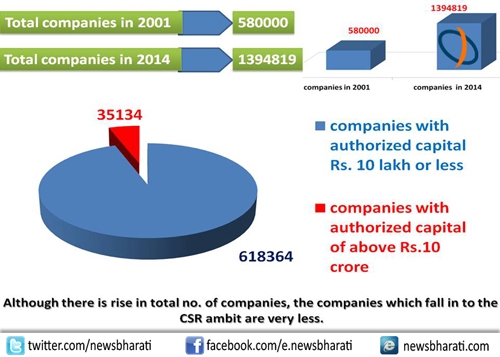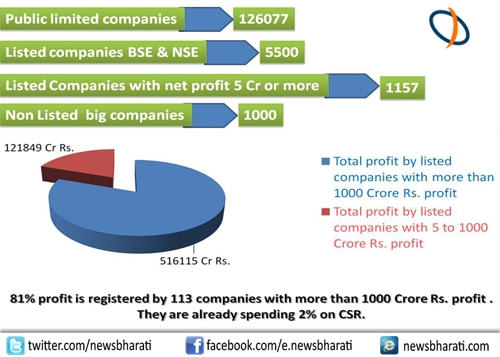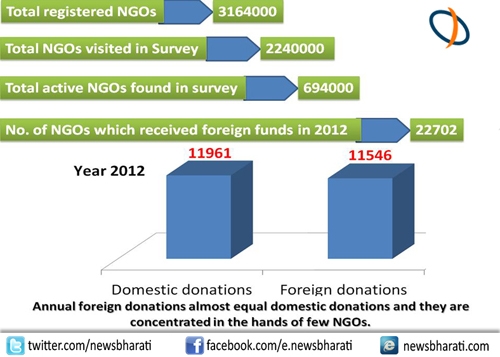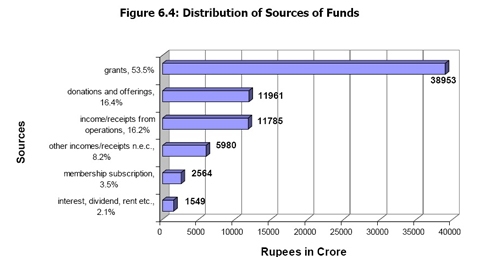Corporate social responsibility, NGOs and Foreign funds
Why foreign funds influence the world of NGOs
The CSR clause in the new company act has raised hopes in the world of NGOs. However due to the absence of authentic information most of the news and debate remains highly speculative.
will India Inc effectively implement CSR? How much funds they will release? How many NGOs are there in India? How many of them get sufficient funds? What is the quantum of funds to be released under CSR as compared to the foriegn funds the NGOs receive?
A Newsbharati analysis of the relevant facts and figures tries to find answers to these questions.
The CSR clause
The CSR Corporate Social Responsibility clause [act 135 of the companies’ act 2013] often comes in the news since the bill was passed by the parliament in August 2013. The act makes it mandatory for every company having net worth of rupees five hundred Crore or more, or turnover of rupees one thousand Crore or more or a net profit of rupees five Crore or more during any financial year, to have a CSR committee consisting of 3 or more directors of which at least one should be an independent director, to spend at least 2 % of their net profit on CSR and to mention it in their annual report. The company will have to give reasons if the specified amount is not spent. There will be no fine as per current act if a company fails to spend the amount, but it will have to mention the reasons for the same.
Since then, all sorts of guesses and estimates are flying in the media. Optimistic estimates are that about 12000 to 15000 Cr. Rs. shall be available for CSR activities in year 2014-15. The impression this figure creates in the mind of average reader is that this much amount will be available as additional resources for NGOs. A careful analysis of the relevant data tells a different story.
The corporate data
The latest data shows that there are 13, 94,819 companies as on 31st March, 2014 out of which 9, 52,433 are active companies. About 64.92% of companies (618364 in number) have authorized capital less than or equal to Rs. 10 lakh each and about 2.1% of companies (35134 in number) have authorized capital of above Rs.10 Crore each.
In 2001 when Ministry of Company affairs released for the first time the data on companies, there were 5.8 lakh companies in India. Thus 8.1 lakh new companies were registered in the period 2001 to 2014. Every year the speed is increasing. In year 2013-14 alone, 98,437 companies were registered with collective authorized capital of Rs. 38,873.83 Crore.

The data shows that the percentage of small companies, which will not come in the ambit of CSR clause 135 mentioned above, is very high. Companies with authorized capital less than one Cr. Rs. are not likely to fall in the ambit of clause 135. Companies with authorized capital of Rs 10 Cr or more are possible candidates for inclusion in CSR clause. There are only 35134 such companies [private as well as public] with authorized capital of 10 Cr or more.
As per the information provided by Smt. Nirmala Sitharaman, MoS in the Ministry of Corporate Affairs in written reply to a question in the Rajya Sabha on 15th July 2014, there are 1,26,077 public limited companies in the country.
For a public limited company to get listed on either BSE or NSE, the minimum post-issue paid-up capital of the applicant company should be Rs. 10 Crore for IPOs & Rs.3 Crore for FPOs; and the minimum issue size should be Rs. 10 Crore. The minimum market capitalization of the Company should be Rs. 25 Crore.
Without going into technical details, it can be easily understood that a listed company should be fairly big. As of now there are about 5500 companies listed on the two national exchanges NSE and BSE. If we go by the single criteria of the net annual profit of 5 Cr, there are 1157 companies listed on BSE or NSE who have registered net profit of Rs 5 Cr or above in their latest available balance sheet. Together they have posted a profit of 637964 Cr Rs. That makes it about 12579 Cr Rs available for CSR activity.
Add to that possibly about thousand companies who have profit of above 5 Cr Rs but who are not listed on stock exchanges and you can add another 1000 Cr to the CSR kitty. The cognisance of non-listed companies should be taken because there are some giant non-listed companies like Nuclear power Corporation of India or Hindustan Aeronautics or BSNL.

However, a closer scrutiny of listed companies reveals that only 113 companies with net profit more than 1000 Cr. Rs. have registered a profit of 516115 Cr Rs and as the available reports show, they are already spending a good amount of their possible CSR kitty of about 10000 Cr Rs on CSR schemes. For example ONGC is already spending 2% of their profit on CSR since 2009. The report mentions
Effective FY 2009-10, our Board of Directors has decided to allocate 2% of the net profit of previous fiscal as our CSR budget. In FY 2009-10, we invested INR 2688 million as part of our community initiatives. We envisage an investment of approximately INR 3200 millions in FY 2010-11.
Therefore, practically at the most about 3000 Cr. Rs. are going to be available as additional funds for NGOs, that too if all the remaining companies implement the CSR.
The NGO data
The general perception is that there is no authentic data on the NGOs in India. Even Home ministry thinks so. The annual report of FCRA for 2011-12 published on 6 December 2013 and signed by Home secretary Anil Goswami mentions
Although there is no centralised database on the number of NGOs in the country and the quantum of finance involved in their operations, unofficial figures indicate that there are over 20 lakh NGOs registered under Societies' Registration Act, Trust Act etc. and thus, the number of NGOs registered under FCRA would be less than 2 per cent of the total number of NGOs.

It is surprising that the Home Ministry is not aware of the report published by another Ministry. In March 2012 the Ministry of statistics published a report ‘final report on non profit institutions’ which is an extensive exercise spanning almost 7-8 years.
 According to the report there were records of 31.64 lakh registered societies in various states. Out of that 22.44 lakh [70.90%] were visited for verification and actually 6.94 NPIs were found to be active and could be traced on the location. It was found that out of the traced societies, maximum number of societies, i.e., 2,53,537 (36.5%) are under Social Services activities, followed by Education & Research, 1,67,136 (24.1%), and Culture & Recreation, 1,06,147 (15.3%). The top three activities account for 76% of the traced societies. It can be seen that the NPI activity boomed rapidly from 1990 onwards. There are 7084333 [70 lakh] people involved in these activities as governing body members. 15501000 [1.5 Cr] people participate in these NPIs as volunteers including governing body members. 2713000 [27 lakh] people are employed by these NPIs, an average of 4 persons per institution.
According to the report there were records of 31.64 lakh registered societies in various states. Out of that 22.44 lakh [70.90%] were visited for verification and actually 6.94 NPIs were found to be active and could be traced on the location. It was found that out of the traced societies, maximum number of societies, i.e., 2,53,537 (36.5%) are under Social Services activities, followed by Education & Research, 1,67,136 (24.1%), and Culture & Recreation, 1,06,147 (15.3%). The top three activities account for 76% of the traced societies. It can be seen that the NPI activity boomed rapidly from 1990 onwards. There are 7084333 [70 lakh] people involved in these activities as governing body members. 15501000 [1.5 Cr] people participate in these NPIs as volunteers including governing body members. 2713000 [27 lakh] people are employed by these NPIs, an average of 4 persons per institution.
The estimates of total value of output of the societies is Rs 41292 Crore which is sum of salary, wages and allowances, honorarium, interest, rent, other operating expenses (goods and services purchased for current activities of institution), provision for depreciation, taxes and consumption of stocks. The estimates of market output i.e. Rs 17765 Crore mainly consist of income/receipts from sale of goods and service produced by institution and miscellaneous incomes, comprising of 43% of the total output. The remaining i.e. Rs 23527 Crore is the non-market output.
These NPIs received total 72792 Cr Rs funds in the year they were surveyed. It may be seen that 53.5% of the funding for these societies comes from grants while 16.4% is from donations and offerings and 16.2% from income/receipts from operations. The remaining 13.8% comes from other sources viz. other incomes/receipts, membership subscription and interest, dividend, rent etc.
 If we deduct the government grant, which mostly goes to educational institutes and the incomes of the NPIs from various sources, it can be seen that 11961 Cr Rs are coming from donations to these institutions, an average of 1.73 lakh Rs per NPI. But here again there are at least 100 mega NPIs of about 100 Cr Rs budget per annum each.
If we deduct the government grant, which mostly goes to educational institutes and the incomes of the NPIs from various sources, it can be seen that 11961 Cr Rs are coming from donations to these institutions, an average of 1.73 lakh Rs per NPI. But here again there are at least 100 mega NPIs of about 100 Cr Rs budget per annum each.
The FCRA data
The foreign contribution to NGOs [or NPIs as termed above, it is one and the same thing] comes under FCRA act of Home ministry. According to the reports of the Ministry the foreign funds are increasing rapidly in last ten years. In year 2004-05, Rs 6,256.68 Cr were received by 18540 organisations while in 2011-12, Rs.11,546.29 Cr were received by 22702 organisations.
This comes to an average of about 50 lakh per organisation. If we compare it to the national average of 1.73 lakh per NPI, we can see that the NPIs receiving foreign funds enjoy a distinct financial advantage in comparison with the NPIs who rely solely on domestic funds.
It should be noted that the amount has almost doubled while the increase in number of organisations is just 22%. This means that foreign funds are being concentrated in the hands of few NPIs who have learned the art of getting foreign funds. For example the world vision India is getting foreign funding of more than 100 Cr Rs per year continuously since 2004.
The implications
Compilation of such data obviously leaves some limitations. The profits of companies are calculated from the latest available annual reports over a span of few months. The government report on nonprofit institutions is a huge exercise which maps about 7 lakh NGOs, but 30% NGOs were not covered in the survey which is also a big number. But still it helps us understand the funding of NGOs and whether CSR provision in company act is going to make any significant impact.
It should be a matter of pride that almost 2 Cr people participate in NGO activity in India, where almost half the population is below poverty line or just above it. It can be seen that the NGOs receiving foreign funds enjoy an advantageous position. Thus only about 22000 NGOs receive 11000 Crore Rs. while rests of the 6.5 lakh NGOs also share the same amount of donations between them. This is where external anti India forces harp on the opportunity as exposed in the newsbharati report ‘IB report, NGOs and the geopolitics of energy’.
IB report, NGOs and the geopolitics of energy
India Inc can help significantly to change the picture, provided it reaches out to NGOs doing path breaking work rather than going by the typical bureaucratic approach. The new CSR provision in company act is not going to have any significant impact. Perhaps the big 100 companies with more than 1000 Cr. Profit should do more. Otherwise foreign funds are going to dominate the world of NGOs for at least coming few years with all its benefits as well as ill effects.
